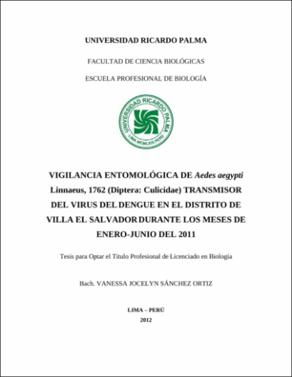Mostrar el registro sencillo del ítem
Vigilancia entomológica de Aedes aegypti Linnaeus, 1762 (Diptera: Culicidae) transmisor del virus del dengue en el distrito de Villa el Salvador durante los meses de enero - junio del 2011
| dc.contributor.advisor | Cobos Zelada, Miguel | |
| dc.contributor.author | Sánchez Ortiz, Vanessa Jocelyn | |
| dc.date.accessioned | 2017-05-31T17:23:28Z | |
| dc.date.available | 2017-05-31T17:23:28Z | |
| dc.date.issued | 2012 | |
| dc.identifier.uri | https://hdl.handle.net/20.500.14138/918 | |
| dc.description.abstract | Aedes aegypti Linnaeus, 1762 es una especie de Diptero que pertenece a la familia Culicidae, subgénero Stegomyia Theobald, 1901. La investigación túvo como objetivos: Realizar vigilancia epidemiológica de Aedes aegypti en el distrito de Villa El Salvador, determinar indicadores entomológicos: Índice Aédico (IA), Índice de Recipientes (IR) e Índice de Breteau (IB) y si existía diferencias significativas entre ellos. Para ellos se realizó un diseño de estudio donde se incluye el protocolo establecido por el Ministerio de Salud para el estudio de la localidad, visita a las viviendas y colección de muestras. Al comparar las fluctuaciones de los Índices Entomológicos (IE): Índice Aédico (IA), Índice de Recipientes (IR) e Índice de Breteau (IB), por sectores y meses se observó que no existieron diferencias estadísticamente significativas. Solo se halló foco positivos de Aedes aegypti durante los meses de Marzo y Abril en los sectores 2 y 3 respectivamente. Aun cuando se focalizó el análisis para los dos meses y sectores, estadísticamente no se encontraron diferencias significativas ni riesgo entomológico; esto último de acuerdo a los porcentaje establecidos en la estratificación de riesgo entomológico.Aedes aegypti Linnaeus, 1762 is a species of Diptera that belongs to the Culicidae family, subgenus Stegomyia Theobald, 1901. This study aimed to: perform a surveillance of Aedes aegypti in the district of Villa El Salvador, determine the entomological indicators: Aédico Index (AI), Container Index (RI) and Breteau Index (BI) and if there were significant differences between them. For those purposes, it a study design that includes the established Ministry of Health protocol for the study of the town, home visitings and sample collection. When comparing the fluctuations of the Entomological indices (EI): Aédico Index (AI), Container Index (RI) and Breteau Index (BI), by sector and months, no statistically significant differences were observed. The only positive focus for Aedes aegypti was found during the months of March and April in sectors two and three, respectively. Although further analysis was focused for the two months and sectors mentiones, no statistically significant differences or entomological risk was found, the latter according to the percentage specified in entomological risk stratification. | es_ES |
| dc.description.sponsorship | Submitted by Wong Rafael (rafel_wl@hotmail.com) on 2017-05-31T17:23:28Z No. of bitstreams: 1 Sánchez_vj.pdf: 1581312 bytes, checksum: 93f8c2d4d4976f8704549cd74394437d (MD5) | es_ES |
| dc.description.sponsorship | Made available in DSpace on 2017-05-31T17:23:28Z (GMT). No. of bitstreams: 1 Sánchez_vj.pdf: 1581312 bytes, checksum: 93f8c2d4d4976f8704549cd74394437d (MD5) Previous issue date: 2012 | es_ES |
| dc.description.uri | Tesis | es_ES |
| dc.format | application/pdf | |
| dc.language.iso | spa | |
| dc.publisher | Universidad Ricardo Palma - URP | es_ES |
| dc.rights | info:eu-repo/semantics/openAccess | |
| dc.rights.uri | https://creativecommons.org/licenses/by-nc-nd/4.0/ | |
| dc.source | Repositorio Institucional - URP | es_ES |
| dc.subject | aedes | es_ES |
| dc.subject | vigilancia | es_ES |
| dc.subject | índices entomológicos | es_ES |
| dc.subject | Villa El Salvador | es_ES |
| dc.subject | surveillance | es_ES |
| dc.subject | entomological indexes | es_ES |
| dc.title | Vigilancia entomológica de Aedes aegypti Linnaeus, 1762 (Diptera: Culicidae) transmisor del virus del dengue en el distrito de Villa el Salvador durante los meses de enero - junio del 2011 | es_ES |
| dc.type | info:eu-repo/semantics/bachelorThesis | |
| thesis.degree.discipline | Biología | es_ES |
| thesis.degree.grantor | Universidad Ricardo Palma. Facultad de Ciencias Biológicas. Escuela Profesional de Biología | es_ES |
| thesis.degree.level | Título Profesional | es_ES |
| thesis.degree.name | Licenciada en Biología | es_ES |
| dc.publisher.country | PE | es_ES |
| renati.type | https://purl.org/pe-repo/renati/type#tesis | |
| renati.level | https://purl.org/pe-repo/renati/nivel#tituloProfesional | |
| renati.discipline | 511206 | |
| dc.type.version | info:eu-repo/semantics/publishedVersion |
Ficheros en el ítem
Este ítem aparece en la(s) siguiente(s) colección(ones)
-
Biología [176]


